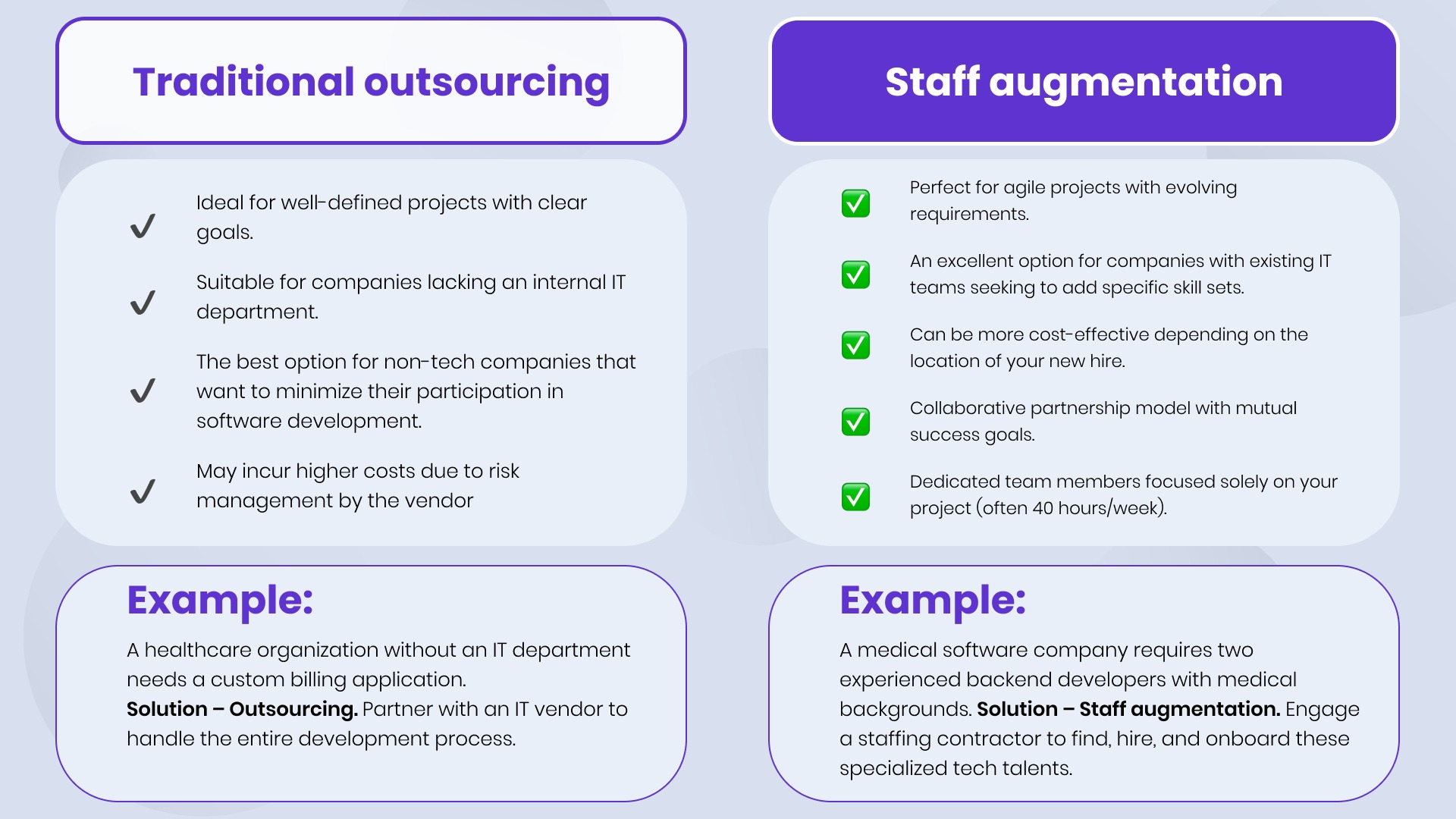
Staff augmentation, once a new player in the hiring game, is quickly becoming a popular choice for businesses seeking IT and digital expertise. It’s no wonder – outstaffing lets you tap into a global pool of highly skilled and specialized professionals, all without the high costs and administrative headaches of traditional hiring.
Intrigued? Read on to discover how staff augmentation can revolutionize your business and take it to the next level.
Content:
- What is staff augmentation, and how can you use it in IT?
- What services do staff augmentation contractors provide?
- Why does staff augmentation win over traditional hiring?
- Staff augmentation vs outsourcing: When opting for one instead of the other?
- Legal considerations of staff augmentation
- Typical terms of a staff augmentation agreement
- 9 reasons to consider staff augmentation
- Why choose MWDN as your staffing provider?
WHAT IS staff augmentation, AND HOW CAN YOU USE IT IN IT?
Staff augmentation is a strategic hiring model that allows you to complement your existing team with specialized professionals on a flexible basis. This model eliminates the risks associated with overhiring permanent employees while ensuring you have the specific skillsets required for current projects.
The dynamic nature of the IT industry makes outstaffing particularly attractive. Rapidly scaling your team becomes effortless, which allows you to adapt to changing workloads and project demands. This agility helps you stay competitive, especially as a tech startup.
The recent tech industry layoffs in 2022 and beyond at major companies like Meta, Amazon, and Google highlight the potential pitfalls of overstaffing. Market analysis suggests one of the key drivers behind these layoffs was aggressive hiring during the pandemic boom.
Here’s where staff augmentation provides a clear advantage: Your outsourced team members remain employees of the staffing provider, mitigating the risk of overstaffing and potential future layoffs for your company.
While outstaffing relieves you of the burden of recruitment, hiring, and HR management, it offers additional advantages particularly relevant to tech companies, like access to a global talent pool, cost-effectiveness, and expertise in IT talent management.
WHAT SERVICES DO staff augmentation CONTRACTORS PROVIDE?
While staff augmentation companies like MWDN excel at recruiting, screening, and onboarding top tech talent for your needs, they offer a much broader range of services that go far beyond simple hiring. Here’s how a quality outstaffing partner becomes a strategic extension of your team:
- Contract management. MWDN acts as a trusted advisor, ensuring all contracts clearly define the rights, responsibilities, and expectations for both you and the remote employee.
- Seamless onboarding. MWDN facilitates smooth integration, introducing your new team members to your company culture, managers, and colleagues. We also provide the necessary equipment and software to ensure they’re productive from day one.
- Employer of Record (EOR) services. Your remote specialists remain officially employed by MWDN, complying with local labor laws (Ukraine, Hungary, Israel, etc.) and ensuring all employee rights are protected.
- Payroll and tax management. Our dedicated team handles all the complexities of payroll processing and tax deductions for your remote team, ensuring your employees receive their salaries on time and you remain compliant with regulations.
- Comprehensive HR management. MWDN’s HR professionals handle everything from leave management and insurance to ongoing training and development.
- Conflict resolution. MWDN’s conflict resolution specialists are skilled at mediating and finding solutions, ensuring a positive and productive working relationship with your remote team.
These are essentially the same functions performed by an in-house HR and recruitment team. However, with staff augmentation, you can access this expertise without the overhead costs and administrative burden of building your own HR department.
Why does staff augmentation win over traditional hiring?
Traditional hiring practices, while familiar, have some limitations. These are some of the key challenges of the traditional approach and how outstaffing offers a compelling alternative.
The pitfalls of traditional hiring
- Limited talent pool. Local recruiting often restricts your search to a geographically defined area. This can be a major drawback when seeking rare specialists or highly experienced professionals.
- High recruiting costs. Skilled technical recruiters understand your specific needs and can identify the best candidates. However, this expertise comes at a premium.
- Overhead costs. Hiring permanent employees means providing office space, equipment, and software. These ongoing expenses can quickly add up.
- Onboarding and training. Integrating new hires takes time and resources that could be directed elsewhere.
- Administrative burden. HR and accounting departments handle payroll, taxes, benefits, and time tracking. Offloading these tasks frees up valuable internal resources.
- Legal and regulatory compliance. Navigating complex employment laws can be costly and time-consuming, especially in regions with strict regulations.
- Limited flexibility. Scaling your team can be difficult with traditional hiring. Staff augmentation offers greater flexibility to adjust your workforce based on project needs.
Staff augmentation addresses these challenges by offering access to a vast network of skilled professionals worldwide and reducing costs.
Staff augmentation vs outsourcing: When opting for one instead of the other?
Staff augmentation and outsourcing, though often confused, serve distinct purposes. Staff augmentation integrates skilled experts into your existing team to work collaboratively on specific goals, while with outsourcing, you delegate a complete business function or project to an external vendor. Both models are valuable, but their applications differ.

Legal considerations of staff augmentation
Even without the need for visas and work permits, legal considerations remain when hiring remote employees abroad through a staff augmentation company. In the case of global hiring, a staff augmentation provider acts as an employer of record (EOR), dramatically facilitating remote employee–abroad employer collaboration.
Legal challenges of global staff augmentation
- Employment classification. The distinction between employee and independent contractor (IC) is crucial. Misclassification can lead to penalties for unpaid taxes and social security contributions. Each country has specific criteria for determining employee status. EORs understand employment classification criteria in different countries, minimizing misclassification risks.
- Taxation. Understanding tax implications for both your company and the remote employee’s country is also important. Taxes may be due in both countries and failing to comply can result in fines and penalties. The EOR handles payroll processing, tax deductions, and remittance, ensuring compliance with local regulations in both your company’s and the employee’s country, which helps avoid double taxation issues.
- Labor laws. Remote employees have certain employment rights depending on their location, such as minimum wage, paid time off, and termination procedures. The EOR ensures compliance with local labor laws, such as minimum wage, paid time off, and termination procedures. They handle required benefits administration where applicable.
- Data security and privacy. As an employer, you have to ensure that data security protocols are in place to protect sensitive business information. You have to understand local data privacy laws in the employee’s country. Reliable EORs, like MWDN, offer data security best practices and guidance on compliance with local data privacy regulations.
By acting as the legal employer for your remote team, a staff augmentation provider specializing in EOR services mitigates risks and simplifies the process.
Typical terms of staff augmentation agreement
Staff augmentation agreement, similar to any employment contract, outlines the rights and responsibilities of both parties. Here’s a what your typical contract will consist of:
Scope of services. This section clearly defines the services provided by the staff augmentation company. This can include recruitment, hiring, payroll, benefits administration, and other HR tasks.
Payment terms. This section details billing rates, IT vendor fees, and how often payment is due. Some outstaffing companies charge a fixed fee, while others may have an hourly rate structure.
Employee benefits. This section outlines the benefits offered to the outstaffed employee, such as healthcare insurance, paid time off, and sick leave. Typically, the staff augmentation company takes responsibility for providing and administering these benefits.
Confidentiality. Non-disclosure agreements (NDAs) are common. Separate agreements may be established between the IT vendor and the client, and the employee and the client. These NDAs ensure the confidentiality of sensitive information shared between the parties.
Intellectual Property (IP). This section clarifies ownership of any intellectual property (IP) developed by the outstaffed employee during their work for the client. Typically, the client retains ownership of any IP created during the engagement.
Termination. This section outlines the conditions under which either party can terminate the agreement. It includes notice periods and any potential penalties or fees associated with early termination.
Dispute Resolution. This section explains the process for resolving disagreements between the client and the outstaffing provider.
Before signing any agreement, carefully review it and negotiate terms to ensure clarity. Both you and your staff augmentation contractor should have a clear understanding of your roles and responsibilities.
9 REASONS to CONSIDER staff augmentation
Staff augmentation offers a compelling solution for businesses seeking to build a high-performing tech team. What benefits will you get from cooperating with a staff augmentation provider?
- Expanded talent pool. Staff augmentation companies have extensive databases of skilled professionals, providing access to a wider range of talent than local recruitment efforts.
- Cost savings. Beyond reduced recruitment and onboarding costs, Staff augmentation can minimize direct labor costs and administrative expenses associated with hiring in-house employees.
- Reduced overhead. The staff augmentation vendor takes care of office space, equipment, software, and utilities for your remote team, eliminating these overhead costs for your business.
- Scalability and flexibility. Easily adjust your team size as project demands fluctuate. This agility ensures you have the right resources at the right time.
- Faster time to market. Staff augmentation allows you to fill critical tech roles quickly, accelerating your time to market and giving you a competitive edge.
- Access to specialized skills. Find niche expertise that may not be readily available in your local market. Staff augmentation partners can connect you with the specific skillsets your project requires.
- Reduced legal and regulatory risks. Staff augmentation companies handle legal and regulatory compliance for their employees, minimizing your exposure to risk and administrative burdens.
- Highly motivated teams. Staff augmentation providers invest in employee motivation, leading to a dedicated and productive team focused on delivering results for your business.
- Improved retention. Outstaffed employees often demonstrate higher loyalty to their employers, potentially leading to lower turnover rates within your project team.
WHY CHOOSE MWDN AS YOUR STAFFING PROVIDER?
MWDN is a leading IT outstaffing provider with over 20 years of experience connecting businesses with top tech talent around the world. We specialize in identifying the perfect fit for your needs, from skilled developers in Eastern Europe to experts in Israel and beyond.
We have a deep understanding of specific industries like healthcare, fintech, logistics, and production. Our team of over 200 professionals boasts extensive experience in a wide range of software development technologies, from JavaScript to C++.
How we help you:
- Streamlined hiring. We handle the entire recruitment process, including sourcing, screening, interviewing, and onboarding.
- Dedicated management. Our team takes care of your remote employees’ payroll, benefits, and administrative needs.
- Cost-effective solutions. We offer affordable fixed-fee structures and are always open to discussing customized solutions.
Ready to build your best team? Contact MWDN today! We’ll be happy to discuss your specific requirements and answer any questions you may have. Let’s schedule a call to explore how our expertise can help you achieve your business goals.
Content
- 1 WHAT IS staff augmentation, AND HOW CAN YOU USE IT IN IT?
- 2 WHAT SERVICES DO staff augmentation CONTRACTORS PROVIDE?
- 3 Why does staff augmentation win over traditional hiring?
- 4 Staff augmentation vs outsourcing: When opting for one instead of the other?
- 5 Legal considerations of staff augmentation
- 6 Typical terms of staff augmentation agreement
- 7 9 REASONS to CONSIDER staff augmentation
- 8 WHY CHOOSE MWDN AS YOUR STAFFING PROVIDER?



